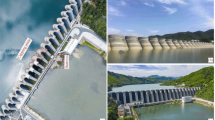Abstract
Predicting “regular” dam deformations for prevailing conditions and comparing them with observed deformations is an essential part of dam surveillance. In many cases prediction and comparison are carried out automatically and an alarm is triggered in the case of larger deviations.
The main contributors to the deformations of arch dams are water loading and the fluctuation of concrete temperature. In general, the deformations exhibit an instantaneous elastic part, a time dependent reversible part and an irreversible part. Prediction of dam deformations can be based on deterministic models, purely statistical models or so-called hybrid models, which are a combination of the first two. Deterministic models rely on static analyses, statistical models on the statistical analysis of previous deformation data.
For annual reservoirs, both water loading and temperature vary in cycles over a period of one year and it is extremely difficult to identify the various factors contributing to an observed deformation. This is particularly true for time-dependent reversible displacements due to the water loading and the portion caused by temperature variation.
The present article deals with the analysis of arch dam deformations based on hybrid models. Particular attention is given to the analysis of the deformations due to temperature fluctuation and to the long-term deformations. The proposed procedure is employed for the analysis of the deformations of the 186 m high Zillergruendl arch dam.
Similar content being viewed by others
References
Swiss Committee on Dams. Methods of Analysis for the Prediction and the Verification of Dam Behaviour. Wasser Energie Luft, 95. Jahrgang, 2003, Heft 3/4, CH-5401 Baden
Lombardi G, Amberg F, Darbre G R. Algorithm for the prediction of functional delays in the behaviour of concrete dams. Hydropower & Dams, 2008, 3: 111–116
Timoshenko S P, Goodier J N. Theory of Elasticity. New York: McGraw-Hill, 1970, 459–466
Obernhuber P, Perner F. Displacements in concrete dams caused by temperature variation. Hydropower & Dams, 2005, Special Issue-Hydro, 80–86
Stucky A, Derron M H. Problèmes thermiques posés par la construction des barrages-réservoirs. École Polytechnique de l’Université de Lausanne, 1957, 164
Carslaw H S, Jaeger J C. Conduction of Heat in Solids. 2nd Ed. Oxford, England: Oxford University Press, 1959, 510
Austrian National Committee on Large Dams. Dams in Austria. 1991
Author information
Authors and Affiliations
Corresponding author
Rights and permissions
About this article
Cite this article
Perner, F., Obernhuber, P. Analysis of arch dam deformations. Front. Archit. Civ. Eng. China 4, 102–108 (2010). https://doi.org/10.1007/s11709-010-0012-7
Received:
Accepted:
Published:
Issue Date:
DOI: https://doi.org/10.1007/s11709-010-0012-7




